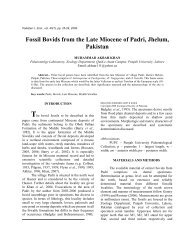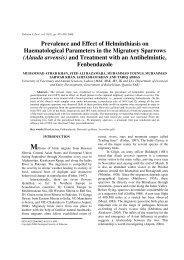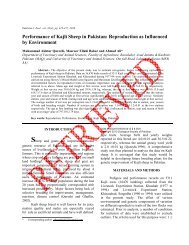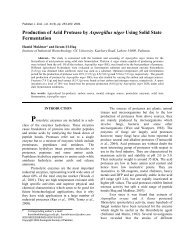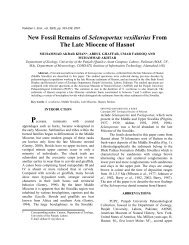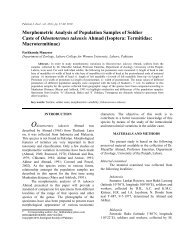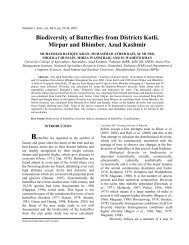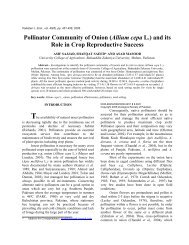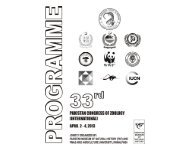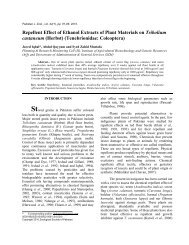A Revision of Hayline Stink Bug Genus Erthesina Spinola - Zsp.com.pk
A Revision of Hayline Stink Bug Genus Erthesina Spinola - Zsp.com.pk
A Revision of Hayline Stink Bug Genus Erthesina Spinola - Zsp.com.pk
Create successful ePaper yourself
Turn your PDF publications into a flip-book with our unique Google optimized e-Paper software.
Pakistan J. Zool., vol. 36(4), pp. 285-293, 2004.<br />
A <strong>Revision</strong> <strong>of</strong> <strong>Hayline</strong> <strong>Stink</strong> <strong>Bug</strong> <strong>Genus</strong> <strong>Erthesina</strong><br />
<strong>Spinola</strong> (Hemiptera: Pentatomidae: Pentatominae) and<br />
Their Clasdistics<br />
IMTIAZ AHMAD, NASREEN MEMON AND SYED KAMALUDIN<br />
Department <strong>of</strong> Zoology, University <strong>of</strong> Karachi (IA), University <strong>of</strong> Sindh Jamshoro (NM), Federal University <strong>of</strong> Arts,<br />
Science an Technology, Gulshan-e-Iqbal Campus, Karachi (SK)<br />
Abstract.- <strong>Hayline</strong> stink bug genus <strong>Erthesina</strong> <strong>Spinola</strong> with its seven known world species is revised with brief<br />
distinguishing features and zoogeographical distribution. The characters <strong>of</strong> each taxon are scanned from the present<br />
descriptions and those given in the literature to date, and their apomorphic states are recognized, on the basis <strong>of</strong> out<br />
group <strong>com</strong>parison within the tribe Haylini at large. A cladogram is also constructed based on the principle <strong>of</strong><br />
parisimony to throw light on the evolutionary relationships <strong>of</strong> the included taxa.<br />
Key words: Insects, Pentatomidae, Halyini, <strong>Erthesina</strong>, revision, Cladistics.<br />
INTRODUCTION<br />
<strong>Spinola</strong> (1837) described <strong>Erthesina</strong> to<br />
ac<strong>com</strong>modate Cimex mucoreus F. (=fullo Thunberg)<br />
from Oriental region. Distant (1902) gave<br />
distinguishing features <strong>of</strong> the genus <strong>Erthesina</strong> and<br />
redescribed the type species fullo (Thunberg)<br />
alongwith acuminata Dallas and guttata (F.) from<br />
Sikhim, Burma, Bangladesh (Jessore), India, Sri<br />
Lanka, Andaman Island, China, Japan, Formosa,<br />
Hainan, north Bengal and Burma. Distant (1908)<br />
described E. robertsi from Sikhim and later (1918)<br />
described another species E. aberrans from north<br />
Bengal but his descriptions were mostly based on<br />
colour features. Ahmad et al. (1974) recorded E.<br />
fullo from different areas <strong>of</strong> NWFP in Pakistan and<br />
from Kashmir and Bangladesh. They also illustrated<br />
dorsal view and metathoracic scent <strong>com</strong>plex through<br />
which it appears that they misidentified their<br />
species. Later Ahmad (1979, 1980) corrected this<br />
misidentification by recording E. fullo only from<br />
Bangaldesh and a manuscript species from different<br />
areas <strong>of</strong> Pakistan i.e. from Punjab and NWFP and<br />
Kashmir. Abbasi (1986) redescribed E. fullo from<br />
Pakistan following Ahmad et al. (1974) earlier<br />
misidentification, <strong>com</strong>pletely ignoring the new stand<br />
<strong>of</strong> Ahmad (1979, 1980) and his illustrations also<br />
appear to be incorrect especially <strong>of</strong> inflated<br />
aedeagus. Ahmad et al. (2002) redescribed E. fullo<br />
0030-9923/2004/0004-0285 $ 4.00/0<br />
Copyright 2004 Zoological Society <strong>of</strong> Pakistan.<br />
highlighting the important features separating it<br />
from not only the described species but also from<br />
the above undescribed species from Pakistan.<br />
Ahmad et al. (2003) finally described his<br />
udnescribed species from Pakistan and Kashmir<br />
with special reference to metathoracic scent<br />
<strong>com</strong>plex and male and female genitalia and gave a<br />
key to world species highlighting cladistic<br />
relationship <strong>of</strong> their new species with the included<br />
taxa. Presently therefore all the seven world species<br />
<strong>of</strong> <strong>Erthesina</strong> alongwith their brief distinguishing<br />
features and zoogeographical distribution are given<br />
and in this light a cladistic analysis is carried out<br />
and a cladogram is constructed on the principle <strong>of</strong><br />
parsimony.<br />
MATERIALS AND METHODS<br />
The works on <strong>Erthesina</strong> <strong>Spinola</strong> by Dallas<br />
(1851), Distant (1902, 1908 and 1918), China<br />
(1925), Ahmad et al. (1974), Ahmad (1979), Abbasi<br />
(1986), Ahmad et al. (2002) and Ahmad et al.<br />
(2003) along with present descriptions were scanned<br />
for the taxonomic characters. The characters were<br />
randomly taken. The polarities <strong>of</strong> these were<br />
deduced not unreasonably. The characters were<br />
<strong>com</strong>pared with those found in the out group within<br />
their tribe at large. No homoplasies had to be<br />
invoked. The results were <strong>com</strong>pared with the<br />
obtained data by Ahmad et al. (2002, 2003) in their<br />
cladistic relationships. Plesiomorphic conditions<br />
showing primitive characters, represented by “ao”,
286<br />
I. AHMAD ET AL.<br />
“bo” and “co” etc. have been listed in the Table I on<br />
characters and characteristics but not taken into<br />
consideration in cladogram (Fig. 3).<br />
<strong>Erthesina</strong> <strong>Spinola</strong><br />
<strong>Erthesina</strong> <strong>Spinola</strong> 1837: 291; Distant 1902: 117;<br />
Ahmad et al., 1974: 54; Ahmad, 1979: 56:<br />
1980; 137; Abbasi, 1986: 111; Ahmad et al.,<br />
2002: 67; Dave-Rider (in unpublished<br />
catalogue <strong>of</strong> Pentatomidae).<br />
Head long, anteriorly narrowed; antennae with<br />
basal segment not reaching head apex; labium with<br />
basal segment extending beyond the bucculae;<br />
metathoracic scent auricle remarkably elongated but<br />
its apex not at all reaching outer margin <strong>of</strong><br />
evaporatoria; anterior and posterior tibiae dilated; in<br />
male pygophore with dorsomedian projection highly<br />
sclerotized, rectangular and bilobed; stem <strong>of</strong><br />
paramere with inner spine; blade bilobed; inflated<br />
aedeagus with pair <strong>of</strong> bilobed dorsal membranous<br />
conjunctival appendages; in female spermathecal<br />
bulb large with three finger-like processes.<br />
Type species<br />
<strong>Erthesina</strong> fullo (Thunberg).<br />
Distribution<br />
China, Japan, Burma, Sri Lanka, India,<br />
Pakistan, Bangladesh, Kashmir, Sikhim and<br />
Andaman Island.<br />
Comparative note<br />
This genus is most closely related to Dalpada<br />
Amyot and Serville in having bilobed paraclypei,<br />
basal antennal segment not reaching apex <strong>of</strong> head<br />
and anterior tibiae dilated but it can easily be<br />
separated from the same in having paraclypei<br />
apically acute, posterior tibiae dilated, humeral<br />
angles <strong>of</strong> pronotum sub-acute and by the other<br />
characters as noted in the description.<br />
<strong>Erthesina</strong> aberrans Distant<br />
(Figs. 1A, 1M)<br />
<strong>Erthesina</strong> aberrans Distant 1918: 121.<br />
Body ochraceous, thickly and coarsely punctate<br />
with black; antennae black, basal segment broadly<br />
streaked with ochraceous, other segments palely<br />
ochraceous at base; head pointed in front, distinctly<br />
shorter than pronotum, lateral margins a little before<br />
the apex <strong>of</strong> 1 st antennal segments spinously notched;<br />
antennae with basal segment stoutest, not reaching<br />
apex <strong>of</strong> head, 2 nd and 3 rd segments subequal, 4 th<br />
longest; pronotum with seven somewhat oblique<br />
longitudinal fasciae <strong>of</strong> dark punctures; anterior and<br />
posterior tibiae more or less normally dilated, all<br />
femora normal; membrane not extending beyond the<br />
abdominal apex; body length 20.00 mm.<br />
Comparative note<br />
This species is most closely related to robertsi<br />
Distant in having 2 nd and 3 rd antennal segments subequal<br />
and 4 th longer than both separately but it can<br />
easily be separated from the same in having<br />
antennae with basal segment broadly streaked with<br />
ochraceous, anterior and posterior tibiae more or<br />
less normally dilated, femora not peculiarly dilated<br />
and by the other characters as noted in the<br />
description.<br />
Distribution<br />
North Bengal.<br />
<strong>Erthesina</strong> acuminata Dallas<br />
(Fig. 2A)<br />
<strong>Erthesina</strong> acuminata Dallas 1851: 183; Distant<br />
1902: 118.<br />
Body grayish testaceous, very thickly punctate<br />
with brown; antennae brown with the two apical<br />
segments pitchy, the base <strong>of</strong> the last segment<br />
orange; head remarkably pointed infront, more or<br />
less equal to pronotum, lateral margins slightly<br />
toothed near the apex; proportions <strong>of</strong> antennal<br />
segments mostly similar to that in E. fullo; labium<br />
long, reaching base <strong>of</strong> last abdominal segment;<br />
dilation <strong>of</strong> the anterior tibiae triangular; all femora<br />
normal; body length 20.00 mm (remaining features<br />
mostly as in E. fullo).<br />
Distribution<br />
Sikhim, Assam, Bangladesh, Sri Lanka, China<br />
and Japan.
REVISION OF GENUS ERTHESINA 287<br />
Fig. 1. Apomorphies: Head, dorsal view; A, E. aberrans; B, E. fullo; C, E. pakistanensis; D-F, antenna, lateral<br />
view, D, E. fullo; E, E. pakistanensis; F, E. robertsi; G-H, Pronotum, dorsal view; G, E. fullo; H, E. pakistanensis; I-<br />
K, Fore tibiae, lateral view, I, E. fullo; J, E. robertsi (with femur); Hind femur and tibia, lateral view, L. E. robertsi;<br />
M, and N, Membrane <strong>of</strong> hemelytra, dorsal view; M, E. aberrans, N, E. pakistanensis.<br />
Comparative note<br />
This species appears isolated in the genus<br />
<strong>Erthesina</strong> in having head prominently acuminate<br />
anteriorly, labium long, reaching to base <strong>of</strong> 7 th<br />
abdominal segment and by the other characters as<br />
noted in the description.<br />
<strong>Erthesina</strong> fullo (Thunberg)<br />
(Figs. 1B, D, G, 1; 2B, F)<br />
Cimex fullo Thunberg 1783: 42.<br />
<strong>Erthesina</strong> fullo, Dallas 1851: 183; Distant 1902:<br />
117; Ahmad et al., 2002: 67-71; Ahmad et al.<br />
2003; 181: 187.
288<br />
I. AHMAD ET AL.<br />
Cimex mucoreus F., 1794: 117; <strong>Erthesina</strong> mucoreus,<br />
<strong>Spinola</strong> 1837: 291.<br />
Body testaceous brown with piceous or<br />
blackish tinge, darkly punctate; antennae brownish<br />
ochraceous; head moderately tapering at apex with<br />
lateral margins <strong>of</strong> paraclypei slightly sinuate, length<br />
more or less equal to pronotum; basal antennal<br />
segment never reaching head apex, second antennal<br />
segment slightly less than 2x basal and distinctly<br />
longer than 3 rd , 4 th less than ½ again longer than 3 rd ,<br />
labium reaching 3 rd abdominal segment; both<br />
anterior and posterior tibiae moderately dilated; all<br />
femora normal; membrane <strong>of</strong> hemelytra well<br />
extending apex <strong>of</strong> abdomen; body length 20.00 to<br />
25.00 mm. Apices <strong>of</strong> first gonocoxae and <strong>of</strong> 9 th<br />
paratergites narrowed but subrounded.<br />
Comparative note<br />
This species is most closely related to<br />
pakistanensis in general appearance and colouration<br />
but it can easily be separated from the same in<br />
having, 2 nd antennal segment distinctly longer than<br />
3 rd , labium reaching to third abdominal segment and<br />
by the other characters as noted in the description.<br />
Distribution<br />
Sikhim, North Bengal and Burma.<br />
<strong>Erthesina</strong> guttata<br />
(Fig. 2C)<br />
Cimex guttata F. 1787: 291; <strong>Erthesina</strong> guttata, Distant<br />
1902: 118.<br />
Body olivaceous green, thickly punctate;<br />
pronotum, scutellum and corium speckled with<br />
small ochraceous collosities; labium reaching to<br />
fourth abdominal segment; anterior and posterior<br />
tibiae moderately lobately dilated; all femora<br />
normal; body length 20.00 – 25.00 mm (remaining<br />
features mostly as in E. fullo).<br />
Comparative note<br />
This species appears isolated among <strong>Erthesina</strong><br />
species in having body olivaceous-green, labium<br />
reaching to fourth abdominal segment and by the<br />
other characters as noted in the description.<br />
Distribution<br />
Sri Lanka.<br />
<strong>Erthesina</strong> ilia China<br />
(Figs. 1J, 2D, G)<br />
<strong>Erthesina</strong> ilia China 1925: 452-453.<br />
Body black with ochraceous spots and<br />
callosities, coarsely punctate; head tapering at apex,<br />
subequal to pronotal length; lateral margins slightly<br />
sinuate; antennae black, basal segment short, not<br />
reaching apex <strong>of</strong> head, 2 nd segment 2x the length <strong>of</strong><br />
basal, 3 rd slightly shorter than 2 nd , 4 th 1½ x the<br />
length <strong>of</strong> 3 rd ; labium reaching middle <strong>of</strong> the 3 rd<br />
abdominal segment; anterior tibiae feebly dilated,<br />
entirely black, all femora normal; membrane <strong>of</strong><br />
hemelytra slightly extending beyond the apex <strong>of</strong> the<br />
abdomen; body length 22.0 mm. Apices <strong>of</strong> 1 st<br />
gonocoxae and 9 th paratergites much narrowed,<br />
subacute.<br />
Comparative note<br />
This species appears closely related to E. fullo<br />
and E. pakistanensis in having 2 nd and 3 rd antennal<br />
segments unequal in length but it appears isolated in<br />
its group in having head, pronotum, scutellum and<br />
legs black, membrane <strong>of</strong> hemelytra slightly<br />
extending beyond apex <strong>of</strong> abdomen, 2 nd antennal<br />
segment only slightly longer than 3 rd , fore tibiae<br />
only feebly dilated and by the other characters as<br />
noted in the description <strong>of</strong> both the species.<br />
Distribution<br />
China.<br />
Taxonomic note<br />
China (1925) on the one hand considered his<br />
species allied to fullo but on the other, on the basis<br />
<strong>of</strong> shape <strong>of</strong> dilation <strong>of</strong> tibiae regarded it very close<br />
to and probably synonymous with robertsi Distant<br />
(from north India) whose type according to him is a<br />
teneral specimen and therefore its contrasting<br />
colours from ilia is not reliable. China (op.cit.)<br />
ignored however that robertsi belongs to aberrans<br />
group with 2 nd and 3 rd antennal segments subequal<br />
in length, in which both anterior and posterior tibiae<br />
are not only much less but also laminately, not
REVISION OF GENUS ERTHESINA 289<br />
Fig. 2. Apomorphies: Labium, ventral view, A, E. acuminata; B, E. fullo; C, E. guttata; D, E. ilia; E, E. robertsi;<br />
F-H, Female terminalia, ventral view; F, E. fullo; G, E. ilia; H, E. pakistanensis.<br />
lobately dilated (but in ilia anterior tibiae are feebly<br />
dilated) and according to the original author<br />
(Distant, 1908) the peculiar dilation <strong>of</strong> the anterior<br />
and posterior femora is a character <strong>of</strong> robertsi<br />
isolating it from all other species <strong>of</strong> <strong>Erthesina</strong>.<br />
<strong>Erthesina</strong> pakistanesis Ahmad et al.<br />
(Figs. 1C, E, H, N; 2H)<br />
<strong>Erthesina</strong> pakistanensis Ahmad et al., 2003: 182.<br />
Body ochraceous brown with black tinge,
290<br />
I. AHMAD ET AL.<br />
densely punctate; antennae dark brown with basal<br />
portions <strong>of</strong> 4 th and 5 th segments ochracenous; head<br />
moderately tapering at apex, with lateral margins <strong>of</strong><br />
paraclypei slightly sinuate, longer than pronotum;<br />
basal antennal segment much shorter than head<br />
apex, 2 nd slightly less than 2x the length <strong>of</strong> basal, 3 rd<br />
distinctly longer than 2 nd , 4 th 1¼ x the length <strong>of</strong> 3 rd ,<br />
labium <strong>of</strong> variable length, reaching the middle <strong>of</strong> 3 rd<br />
to base <strong>of</strong> 6 th abdominal venter; both anterior and<br />
posterior tibiae moderatelyly lobately dilated, all the<br />
femora normal; membrane <strong>of</strong> hemelytra moderately<br />
passing beyond apex <strong>of</strong> abdomen; body length 26.8<br />
– 27.5 mm. Apices <strong>of</strong> 1 st gonocoxae and 9 th<br />
paratergites narrowed but subround.<br />
Comparative note<br />
It is most closely related to fullo in general<br />
appearance but it can easily be separated from the<br />
same in having 2 nd antennal segment distinctly<br />
shorter than the 3 rd , labium <strong>of</strong> variable length<br />
reaching from middle <strong>of</strong> 3 rd upto 6 th abdominal<br />
venter and by the other characters as noted in the<br />
description <strong>of</strong> both the species.<br />
Distribution<br />
Punjab and NWFP in Pakistan and Kashmir.<br />
<strong>Erthesina</strong> robertsi Distant 1908: 434<br />
(Figs. 1F, K, L, ZE)<br />
Body testaceous brown with piceous or<br />
blackish tinge, darkly punctate; antennae brownish<br />
ochraceous, head tapering at apex, as long as<br />
pronotum, lateral margin obscurely toothed or<br />
notched below apex; antennae with basal segment<br />
slightly thickened, not nearly reaching head apex,<br />
2 nd and 3 rd segments subequal and slightly shorter<br />
than 4 th separately; labium reaching to base <strong>of</strong> 5 th<br />
abdominal venter; anterior and posterior tibiae<br />
laminately, not lobately and much less dilated,<br />
anterior and posterior femora peculiarly dilated;<br />
membrane <strong>of</strong> hemelytra moderately extending apex<br />
<strong>of</strong> abdomen; body length 21.50 mm.<br />
Comparative note<br />
This species is most closely related to aberrans<br />
in having 2 nd and 3 rd antennal segments subequal<br />
and 4 th longer than both separately but it can easily<br />
be separated from the same in having head as long<br />
as pronotum, anterior and posterior tibiae much less<br />
and laminately not lobately dilated and anterior and<br />
posterior femora peculiarly dilated.<br />
Distribution<br />
Sikhim.<br />
Table I.-<br />
Characters and character states<br />
a 0 Body moderate-sized.<br />
a 1 Body large-sized (all included taxa).<br />
b 0 Head and antennae light in colour.<br />
b 1 Head and antennae at least slightly dark in colour (all<br />
included taxa).<br />
b 2 Head and antennae light gray or brown with base <strong>of</strong> apical<br />
segments orange in colour (acuminata)<br />
b 3 Head and antennae darker, somber, castaneous or nigrous<br />
(all <strong>Erthesina</strong> spp. except acuminata).<br />
b 4 Head olivaceous green, coarsely punctate (guttata).<br />
b 5 Head ochraceous, brownish black, prickly punctate with<br />
black (all <strong>Erthesina</strong> spp., except acuminata and guttata).<br />
b 6 Head and antennae black, coarsely punctate (ilia).<br />
c 0 Antennae dull pale.<br />
c 1 Antennae piceous with base <strong>of</strong> apical segment ochraceous<br />
(fullo).<br />
c 2 Antennae brownish ochraceous (robertsi).<br />
c 3 Antennal segments dark brown with basal portion <strong>of</strong> 4 th<br />
and 5 th segments ochroceous (pakistanensis).<br />
c 4 Antennae black with basal segment broadly streaked<br />
black with ochraceous, other segments pale ochraceous at<br />
base (aberrans).<br />
c 5 Antennae entirely black (ilia).<br />
d 0 Ocelli pale.<br />
d 1 Ocelli pink (pakistanensis).<br />
d 2 Ocelli ochraceous (fullo).<br />
e 0 Pronotum, scutellum and corium unicolourous, light<br />
coloured.<br />
e 1 Pronotum and scutellum brownish black with ochraceous<br />
spots (pakistanensis and fullo).<br />
e 2 Pronotum, scutellum and corium testaceous brown and<br />
darkly punctate (robertsi).<br />
e 3 Pronotum, scutellum and corium black with ochraceous<br />
spots and callosities (ilia).<br />
f 0 Head equal to pronotum (most species).<br />
f 1 Head somewhat longer than pronotum (pakistanensis).<br />
f 2 Head distinctly shorter than pronotum (aberrans).<br />
g 0 Head anteriorly rounded.<br />
g 1 Head less acuminate anteriorly (most species except<br />
acuminata).<br />
g 2 Head much acuminate (acuminata).<br />
h 0 &h a0 Second, 3 rd and 4 th antennal segments equal to each<br />
other.<br />
h 1 Second and third antennal segments sub-equal (robertsi<br />
and aberrans).<br />
Second antennal segment shorter or longer than 3 rd (ilia,<br />
h 2
REVISION OF GENUS ERTHESINA 291<br />
fullo and pakistanensis).<br />
h 3 Second antennal segments slightly longer than 3 rd (ilia).<br />
h 4 Second antennal segment distinctly longer than 3 rd (fullo).<br />
h 5 Second antennal segment distinctly shorter than 3 rd<br />
(pakistanensis).<br />
h a1 Fourth antennal segment longer than 2 nd and 3 rd separately<br />
(robertsi and aberrans).<br />
h a2 Fourth antennal segment about 1¼ longer than 3 rd (fullo<br />
and pakistanensis).<br />
h a3 Fourth antennal segment about 1½ longer than 3 rd (ilia).<br />
i 0 Labium moderately long, passing beyond hind coxae.<br />
i 1 Labium passing distinctly beyond hind coxae (in all taxa).<br />
i 2 Labium reaching to middle <strong>of</strong> 3 rd abdominal venter (ilia).<br />
i 3 Labium well reaching to 3 rd abdominal venter (fullo).<br />
i 4 Labium <strong>of</strong> variable length, reaching to from 3 rd to base <strong>of</strong><br />
6 th abdominal venter (pakistanensis)<br />
i 5 Labium reaching to 4 th abdominal segment (guttata).<br />
i 6 Labium reaching to 5 th abdominal venter (robertsi).<br />
i 7 Labium reaching to base <strong>of</strong> last abdominal segment<br />
(acuminata).<br />
j 0 Anterior and posterior femora not dilated.<br />
j 1 Anterior and posterior femora peculiarly dilated<br />
(robertsi).<br />
k 0 Anterior and posterior tibiae smoothly elongated.<br />
k 1 Only anterior tibiae dilated posterior tibiae cylinderical<br />
(Dalpada).<br />
k 2 Anterior and posterior tibiae more or less dilated (in most<br />
taxa <strong>of</strong> <strong>Erthesina</strong>).<br />
k 3 Anterior tibiae only feeby dilated (ilia).<br />
k 4 Anterior tibiae triangularly dilated (acuminata).<br />
k 5 Anterior and posterior tibiae not lobately but laminately<br />
and much less dilated (robertsi).<br />
l 0 Hemelytra reaching to apex <strong>of</strong> abdomen.<br />
l 1 Hemelytra reaching beyond apex <strong>of</strong> abdomen (in most<br />
<strong>Erthesina</strong> spp.<br />
l 2 Hemelytra short <strong>of</strong> apex <strong>of</strong> abdomen (aberrans).<br />
m 0 Apices <strong>of</strong> 1 st gonocoxae and 9 th paratergites round.<br />
m 1 Apices <strong>of</strong> 1 st gonocoxae and 9 th paratergites narrowed<br />
(fullo, pakistanensis and ilia).<br />
m 2 Apices <strong>of</strong> 1 st gonocoxae and 9 th paratergites subacute<br />
(ilia).<br />
Explanation <strong>of</strong> characters and character states.<br />
Body size (a)<br />
Body large-sized 20.00 mm long or more than<br />
20.00 mm in length in robertsi, aberrans,<br />
acuminata, fullo, guttata, robertsi and pakistanensis<br />
shows their synapomorhic condition (a).<br />
Patches and pigmentations <strong>of</strong> head and<br />
antennae (b)<br />
Head and antennae slightly dark in most<br />
species reflect their synapomorphic state (b 1 ). Head<br />
and antennae light gray or brown with base <strong>of</strong> apical<br />
segments orange in acuminata show its<br />
autapomorphic condition (b 2 ). Head and antennae<br />
darker, somber, castaneous or nigrous in all<br />
<strong>Erthesina</strong> spp., except in acuminata show their<br />
synapomorphic condition (b 3 ). In guttata the head<br />
olivaceous green, coarsely punctate shows its more<br />
derived autapomorphic condition (b 4 ). Head<br />
ocharceous, prickly punctate with black in aberrants<br />
(and remaining taxa) shows its more derived<br />
autapomorphic state (b 5 ). Head black coarsely<br />
punctate in ilia appears most specialized<br />
autapomorphic condition (b 6 ).<br />
Colour <strong>of</strong> antennal segments (c)<br />
Antennae piceous with base <strong>of</strong> apical segment<br />
ochraceous (c 1 ). In robertsi antennae brownish<br />
ochraceous show derived autapomorphic condition<br />
(c 2 ). Antennal segments dark brown with basal<br />
portion <strong>of</strong> 4 th and 5 th segments ochraceous show<br />
more derived autapomorphic condition (c 3 ) in<br />
pakistanesis. In aberrans the antennae appear black<br />
having basal segments broadly streaked black with<br />
ochraceous and other segments pale ochraceous at<br />
base show its further derived autapomorphic state<br />
(c 4 ). In ilia antennae entirely black show its most<br />
derived autapomorphic condition (c 5 ).<br />
Ocelli (d)<br />
Ocelli pink in pakistanensis show its<br />
autapomorphic condition (d 1 ). In fullo the ocelli<br />
appear ochraceous and show derived autapomorphic<br />
state (d 2 ).<br />
Colour <strong>of</strong> pronotum, scutellum and corium (e)<br />
Pronotum and scutellum brownish black with<br />
ochraceous spots in pakistanensis and fullo show<br />
their synapomorphic condition (e 1 ). In robertsi the<br />
pronotum, scutellum and corium are testaceous<br />
brown with darkly punctate appearance show<br />
autapomorphic state (e 2 ). Pronotum, scutellum and<br />
corium with ochraceous spots and callosities in ilia<br />
show its more derived autapomorphic condition (e 3 ).<br />
Head / pronotal length (f)<br />
Head somewhat longer than pronotum in<br />
pakistanensis shows its autapomorphic condition<br />
(f 1 ). In aberrans head distinctly shorter than<br />
pronotum shows its derived autapomorphic state<br />
(f 2 ).
292<br />
I. AHMAD ET AL.<br />
Head shape (g)<br />
Head less acuminate anteriorly in most<br />
<strong>Erthesina</strong> species except in acuminata shows<br />
synapomorphic condition (g 1 ). In acuminata much<br />
acuminate head shows its more derived<br />
autapomorphic state (g 2 ).<br />
Ratio <strong>of</strong> antennal segments (h and ha)<br />
Second antennal segments sub-equal to third in<br />
robertsi and aberrans show their synapomorphic<br />
condition (h 1 ). In ilia, fullo and pakistanensis 2 nd<br />
antennal segments shorter or longer than 3 rd show<br />
their derived synapomorphic condition (h 2 ). Second<br />
antennal segments only slightly longer than 3 rd in<br />
ilia show its more derived autapomorphic condition<br />
(h 3 ). Second antennal segments distinctly longer<br />
than 3 rd in fullo show its further derived<br />
autapomorphic condition (h 4 ). In pakistanensis 2 nd<br />
antennal segments distinctly shorter than 3rd show<br />
its remarkably derived autapomorphic state (h 5 ). In<br />
aberrans and robertsi 4 th antennal segments<br />
distinctly longer than 2 nd and 3 rd separately show<br />
their much derived synapomorphic state (h a1 ). In<br />
fullo and pakistanensis 4 th antennal segments about<br />
1¼ x longer than 3 rd show their further derived<br />
synapomorphic condition (h a2 ). In ilia 4 th antennal<br />
segments 1½ x longer than 3 rd show its most derived<br />
autapomorphic state (h a3 ).<br />
Labial reach (i)<br />
Labium reaching from 3 rd to base <strong>of</strong> 7 th<br />
abdominal venter in aberrans, acuminata, guttata,<br />
fullo, ilia, pakistanensis and robertsi shows their<br />
synapomorphic condition (i 1 ). In ilia labium<br />
reaching to middle <strong>of</strong> 3 rd abdominal venter shows its<br />
autapomorphic state (i 2 ). In fullo labium well<br />
reaching to 3 rd abdominal venter shows its more<br />
derived autapomorphic state (i 3 ). Labium <strong>of</strong> variable<br />
length, reaching from 3 rd to base <strong>of</strong> 6 th abdominal<br />
venter in pakistanensis appears more derived state<br />
(i 4 ). Labium reaching 4 th abdominal venter in<br />
guttata shows its further derived autapomorphic<br />
condition (i 5 ). In robertsi labium well reaching to 5 th<br />
abdominal venter shows its further more derived<br />
state (i 6 ). In acuminata the labium reaching upto<br />
base <strong>of</strong> last abdominal venter shows its most derived<br />
state (i 7 ).<br />
Anterior and posterior femora (j)<br />
Anterior and posterior femora peculiarly<br />
dilated in robertsi show its autapomorphic state (j 1 ).<br />
Anterior and posterior tibiae (k)<br />
Anterior tibiae dilated in all the species <strong>of</strong><br />
Dalpada show their synapomorphic condition (k 1 ).<br />
In all the representatives <strong>of</strong> the genus <strong>Erthesina</strong> the<br />
anterior and posterior tibiae are more or less dilated<br />
which show their derived synapomorphic state (k 2 ).<br />
In ilia anterior tibiae are feebly dilated which show<br />
its autamorphic state (k 3 ). In acuminata anterior<br />
tibiae are triangularly dilated which show its more<br />
derived autapomorphic state (k 4 ). In robertsi<br />
anterior and posterior tibiae are not lobately but<br />
laminately and much less dilated which show its<br />
most derived autapomorphic state (k 5 ).<br />
Reach <strong>of</strong> hemelytra (l)<br />
In most <strong>Erthesina</strong> species hemelytra reaching<br />
beyond apex <strong>of</strong> abdomen shows synapomorphic<br />
condition (l 1 ). In aberrans hemelytra short <strong>of</strong><br />
abdomen shows derived autapomorphic state (l 2 ).<br />
Shape <strong>of</strong> 1 st gonocoxae and 9 th paratergites in<br />
female genitalia (m)<br />
Apices <strong>of</strong> 1 st gonocoxae and 9 th paratergites<br />
narrowed in fullo, pakistanensis and ilia show their<br />
synapomorphic condition (m 1 ). Apices <strong>of</strong> 1 st<br />
gonocoxae and 9 th paratergites subacute in ilia show<br />
its more derived state (m 2 ).<br />
DISCUSSION<br />
The genus <strong>Erthesina</strong> <strong>Spinola</strong> <strong>com</strong>prises seven<br />
world species viz., aberrans, acuminata, fullo,<br />
guttata, ilia, pakistanensis and robertsi with anterior<br />
and posterior tibiae dilated fall into two groups<br />
(Fig.3). Group I consists <strong>of</strong> only one species<br />
acuminata which plays out group relationships with<br />
the entire clade in having apomorphies <strong>of</strong> head<br />
much acuminate anteriorly (g 3 ) and labium very<br />
long reaching to base <strong>of</strong> abdominal venter (i 2 ).<br />
Group II again is divided into two subgroups.<br />
Subgroup-I includes only guttata with<br />
autapomorphies <strong>of</strong> head olivaceous green (b 4 ). The<br />
subgroup-II is further divided into two minor<br />
subgroups. Subgroup-Ia includes robertsi and
REVISION OF GENUS ERTHESINA 293<br />
Fig. 3. Cladogram showing relationships<br />
<strong>of</strong> the included taxa.<br />
aberrans which play sister group relationships with<br />
each other and outgroup relationships with the<br />
remaining clade in having 2 nd and 3 rd antennal<br />
segments subequal (h 1 ). The second subgroup-Ib<br />
includes fullo, ilia and pakistanensis, in which fullo<br />
and pakistanensis play sister group relationship with<br />
each other in having apomorphies <strong>of</strong> 4 th antennal<br />
segments about 1¼ x longer than 3 rd (h a2 ) while the<br />
species <strong>of</strong> ilia plays outgroup relationship with the<br />
former in having head entirely black and coarsely<br />
punctate (b 6 ). The present results generally support<br />
those <strong>of</strong> Ahmad et al. (2002, 2003).<br />
REFERENCES<br />
ABBASI, Q.A., 1986. Morpho-taxonomic studies <strong>of</strong> the family<br />
Pentatomidae Leach. 1815 (Heteroptera:Pentatomomorpha)<br />
<strong>of</strong> South Asia (Pakistan, Azad Kashmir and Bangladesh)<br />
with reference to the phylogeny <strong>of</strong> the group. Pakistan J.<br />
ent. Karachi Suppl., 5: 105-247.<br />
AHMAD, I., 1979. A revision <strong>of</strong> the superfamilies Coreoidea<br />
and Pentatomoidea (Heteroptera: Pentatomomorpha) from<br />
Pakistan, Azad Kashmir and Bangladesh. Part-I.<br />
Additions and corrections <strong>of</strong> coreid and pentatomid fauna<br />
with phylogenetic considerations. Kar. ent. Soc. Suppl., 4:<br />
1-113.<br />
AHMAD, I., 1980. Insect fauna <strong>of</strong> Pakistan and Azad Kashmir:<br />
Some groups within the order Hemiptera. Proc. Pakistan<br />
Congr. Zool., 1A: 115-155.<br />
AHMAD, I., ABBASI, Q.A. AND KHAN, A.A., 1974. Generic<br />
and supergeneric keys with reference to a check-list <strong>of</strong><br />
pentatomid fauna <strong>of</strong> Pakistan (Hemiptera: Pentatomidae)<br />
with notes on their distribution and food plants. Kar. ent.<br />
Soc. Suppl., 1: 1-103.<br />
AHMAD, I., MEMON, N. AND KAMALUDDIN, S., 2002.<br />
Redescription <strong>of</strong> <strong>Erthesina</strong> <strong>Spinola</strong> with its type species<br />
fullo (Thunberg) (Heteroptera: Pentatomidae:<br />
Pentatominae: Halyini) and their cladistic relationship.<br />
Bull. Pure appl. Sci. India, 21a: 67-71.<br />
AHMAD, I., MEMON, N. AND KAMALUDDIN, S., 2003. A<br />
new species <strong>of</strong> halyine genus <strong>Erthesina</strong> <strong>Spinola</strong><br />
(Hemiptera: Pentatomidae) from Pakistan with a key to its<br />
world species: their distribution and cladistic<br />
relationships. Bull. Pure appl. Sci. India, 22: 181-189.<br />
CHINA, W.E., 1925. On Hemiptera from Yunnan. Ann. Mag.<br />
Nat. Hist. Ser. 9, 16: 452-453.<br />
DALLAS, W.S., 1851. List <strong>of</strong> Hemipterous insects. Coll. Brit.<br />
Mus., 1: 1-368.<br />
DISTANT, W.L., 1902. The fauna <strong>of</strong> British India including<br />
Ceylon and Burma. Rhynchota, vol. 1. Taylor and<br />
Francis, London.<br />
DISTANT, W.L., 1908. The fauna <strong>of</strong> British India including<br />
Ceylon and Burma. Rhynchota, vol. 4. Taylor and<br />
Francis, London.<br />
DISTANT, W.L., 1918. The fauna <strong>of</strong> British India including<br />
Ceylon and Burma. Rhynchota, vol. 7. Taylor and<br />
Francis, London.<br />
FABRICIUS, J.C., 1794. Entomologica systematica emendata<br />
et aucta secundum, classes, ordines, genera, species,<br />
adjectis, synonymis, locis, observationibus,<br />
descriptionibus. Hafniae, 4: 117.<br />
SPINOLA, M., 1837. Essai sur les genres d’ insectes<br />
appartenants a’ l’ ordre des Hemipteres Linn., on<br />
Rhyngotes Fabricius et a’ la section des Heteropteres,<br />
Dufour. Chez. Yves. Gravier. Genes, 1837: 257-383.<br />
(Received 4 March 2004)



